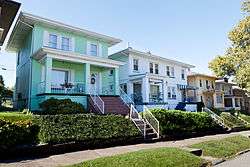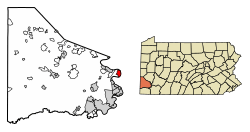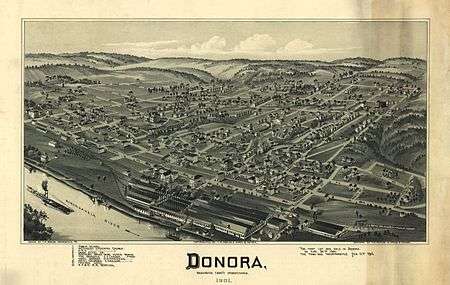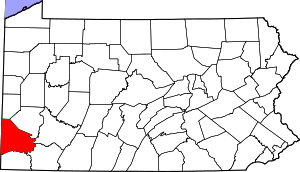Donora, Pennsylvania
Donora is a borough in Washington County, Pennsylvania, United States, approximately 20 miles (32 km) south of Pittsburgh on the Monongahela River.
Donora | |
|---|---|
 Concrete houses in the Cement City neighborhood | |
| Etymology: portmanteau of "William Donner" and "Nora Mellon" | |
 Location of Donora in Washington County, Pennsylvania. | |
 Donora Location of Donora in Pennsylvania | |
| Coordinates: 40°10′33″N 79°51′41″W | |
| Country | United States |
| State | Pennsylvania |
| County | Washington |
| Established | 1900 |
| Government | |
| • Mayor | James McDonough II |
| Area | |
| • Total | 2.05 sq mi (5.30 km2) |
| • Land | 1.90 sq mi (4.92 km2) |
| • Water | 0.15 sq mi (0.38 km2) |
| Population (2010) | |
| • Total | 4,781 |
| • Estimate (2019)[2] | 4,562 |
| • Density | 2,402.32/sq mi (927.30/km2) |
| Time zone | UTC-4 (EST) |
| • Summer (DST) | UTC-5 (EDT) |
| ZIP code | 15033 |
| Area code(s) | 724 Exchange: 379 |
| Website | DonoraBoro.org |

Donora was incorporated in 1901. It got its name from a combination of William Donner and Nora Mellon, banker Andrew W. Mellon's wife. The borough's nickname is "The Home of Champions", mainly because of the large number of famous athletes who have called Donora their home.
Agriculture, coal-mining, steel-making, wire-making, and other industries were conducted in Donora early in its history.
In 1910, 8,174 people lived in Donora; in 1920, 14,131; and in 1940, 13,180. According to U.S. census figures, the population was 5,653 in 2000 and 4,781 in 2010.[3]
Donora is a Rust Belt location which has lost most of its industrial capacity.
It is in the "Mon valley", 5 miles (8.0 km) downriver from Charleroi and 25 miles (40 km) upstream of Braddock.
History
In 1794, the Whiskey Insurrectionists held several meetings at Fells Church, approximately 1 mile (1.6 km) east of Donora.
A trolley line opened in Donora on December 15, 1901, linking First and McKean, and Fifteenth Street and Meldon.[4] It was extended in 1911 to Black Diamond to connect to the Charleroi to Pittsburgh interurban trolley. The line was abandoned on May 5, 1953.
The town was the scene of the infamous Donora Smog of 1948. Between October 26 and October 31, 1948, an air inversion trapped industrial effluent (air pollution) from the American Steel and Wire plant and Donora Zinc Works. During this spike in air pollution, 6,000 people suffered respiratory problems and extreme discomfort.[5] "In three days, 20 people died... After the inversion lifted, another 50 died, including Lukasz Musial, the father of baseball great Stan Musial. Hundreds more finished the rest of their lives with damaged lungs and hearts."[6] The incident made national headlines. Today, the town is home to the Donora Smog Museum which tells the impact of the Donora Smog on the air quality standards enacted by the federal government in subsequent years.[7]
Donora's neighborhood known as "Cement City" is listed on the National Register of Historic Places.[8] The homes built in the neighborhood are completely made out of pre-formed and poured concrete. This structural building technique was championed by Thomas Edison, and was used by neighborhoods throughout the United States. The homes were built as employee housing for the Donora Wire and Steel Mill in the early 1900s.[9]
The Cement City Historic District and Webster Donora Bridge are also listed on the National Register of Historic Places.[10]
Geography
Donora is located at 40°10′33″N 79°51′41″W (40.175879, −79.861264).[11]
According to the United States Census Bureau, the borough has a total area of 2.0 square miles (5.2 km2), of which 1.9 square miles (4.9 km2) is land and 0.2 square miles (0.5 km2) (7.32%) is water.
Climate
The climate in this area is characterized by hot, humid summers and generally mild to cool winters. According to the Köppen Climate Classification system, Donora has a humid subtropical climate, abbreviated "Cfa" on climate maps.[12]
| Climate data for Donora, Pennsylvania | |||||||||||||
|---|---|---|---|---|---|---|---|---|---|---|---|---|---|
| Month | Jan | Feb | Mar | Apr | May | Jun | Jul | Aug | Sep | Oct | Nov | Dec | Year |
| Average high °C (°F) | 4.6 (40.3) |
6.1 (42.9) |
11.5 (52.7) |
18.2 (64.8) |
23.8 (74.8) |
28.0 (82.4) |
29.9 (85.8) |
29.2 (84.5) |
25.9 (78.6) |
19.6 (67.3) |
12.5 (54.5) |
6.2 (43.1) |
17.9 (64.3) |
| Average low °C (°F) | −4.9 (23.1) |
−4.4 (24.0) |
−0.4 (31.2) |
4.6 (40.2) |
9.9 (49.8) |
15.0 (59.0) |
17.2 (63.0) |
16.7 (62.0) |
13.0 (55.4) |
6.7 (44.1) |
1.8 (35.3) |
−3.0 (26.6) |
6 (43) |
| Average precipitation mm (inches) | 66 (2.6) |
56 (2.2) |
86 (3.4) |
84 (3.3) |
97 (3.8) |
97 (3.8) |
94 (3.7) |
94 (3.7) |
74 (2.9) |
66 (2.6) |
69 (2.7) |
64 (2.5) |
940 (37.2) |
| Source: Weatherbase [13] | |||||||||||||
Surrounding and adjacent neighborhoods
Donora is only bordered by land with Carroll Township to the north, south and west. Across the Monongahela River to the east, Donora runs adjacent with Rostraver Township in Westmoreland County.
Government
Donora is a borough and consists of an elected mayor and an elected borough council.
Mayor Donald "Piglet" Pavelko was recently appointed to the position of mayor by the Donora Borough Council after the previous mayor John "Chummy" Lignelli resigned in order to better enjoy his retirement. Lignelli served for nearly three decades. At age 92 when he retired, he was one of the oldest seated mayors in the United States.
Chief of Police is James Brice.
Council President is Dennis Gutierrez.
Schools
Donora is part of Ringgold School District, which includes the municipalities of Donora, Monongahela, Carroll Township, Nottingham Township, New Eagle, Finleyville, and Union Township. As of 2011, the district no longer operates any facilities within the borough that house academic classrooms for students.
Donora's youth sports mascot is the Donora Dragon and its colors are orange and black. Since the merge of the elementary and middle schools, there is no longer Donora Dragon football or cheerleading.
Demographics
| Historical population | |||
|---|---|---|---|
| Census | Pop. | %± | |
| 1910 | 8,174 | — | |
| 1920 | 14,131 | 72.9% | |
| 1930 | 13,905 | −1.6% | |
| 1940 | 13,180 | −5.2% | |
| 1950 | 12,186 | −7.5% | |
| 1960 | 11,131 | −8.7% | |
| 1970 | 8,825 | −20.7% | |
| 1980 | 7,524 | −14.7% | |
| 1990 | 5,928 | −21.2% | |
| 2000 | 5,653 | −4.6% | |
| 2010 | 4,781 | −15.4% | |
| Est. 2019 | 4,562 | [2] | −4.6% |
| Sources:[14][15][16][17] | |||
As of the census[16] of 2000, there were 5,653 people, 2,469 households, and 1,434 families residing in the borough. The population density was 2,973.8 people per square mile (1,148.8/km²). There were 2,958 housing units at an average density of 1,556.1 per square mile (601.1/km²). The racial makeup of the borough was 82.10% White, 14.84% African American, 0.14% Native American, 0.27% Asian, 0.02% Pacific Islander, 0.32% from other races, and 2.32% from two or more races. Hispanic or Latino people of any race were 2.02% of the population.
There were 2,469 households out of which 23.4% had children under the age of 18 living with them, 36.9% were married couples living together, 16.5% had a female householder with no husband present, and 41.9% were non-families. 37.4% of all households were made up of individuals and 21.3% had someone living alone who was 65 years of age or older. The average household size was 2.23 and the average family size was 2.95.
In the Washington County borough the population was spread out with 21.7% under the age of 18, 6.4% from 18 to 24, 25.5% from 25 to 44, 21.4% from 45 to 64, and 25.0% who were 65 years of age or older. The median age was 42 years. For every 100 females, there were 82.7 males. For every 100 females age 18 and over, there were 78.4 males.
The median income for a household in the borough was $27,939, and the median income for a family was $37,176. Males had a median income of $33,725 versus $22,346 for females. The per capita income for the borough was $17,893. About 12.4% of families and 16.8% of the population were below the poverty line, including 28.2% of those under age 18 and 14.0% of those age 65 or over.
Industry
Though many group Donora in a class of Western Pennsylvania towns and cities known collectively as the "rust belt" because of the demise of the once prolific steel industry, the town continues to be a center for industry and manufacturing. On the site of the former steel mills now stands a large industrial park that is managed by MMIDA (Mid Mon Valley Industrial Development Authority).
Major companies that have facilities in the Donora Industrial Park include A-1 Babbit company, Apex N.A., Area Agency on Aging, Bergen Power Pipe Supports, BMA of Donora, HYTEC Inc., Dyno-Nobel Inc, Eastern Alloy, Eastern Hydraulic & Machine, Elizabeth Milling Corporation, Elliott Support Services, Glosser MFG, Industrial Nonferrous Casting Company, K-Z Tool Company, Airgas Specialty Products, Inc. (formerly LaRoche Industries), McGrew Welding Fabrication, Metalife Resources, MIDA Inc., Mon Valley Child Care, Mon Valley Sewage Authority, Monessen Ambulance Service, Nitrous Oxide Corporation, Power & Industrial Services Corporation, Nichols Miniatures, Pittsburgh Post Gazette Distribution Center, RAS Industries Inc., Regal Industries Inc.and Spartech Polycom.[18]
Cement City
Donora is home to the world's second largest "Cement City" housing tract, innovated by Thomas Edison. The Cement City Historic District consists of 80 "poured in place" homes.[19]
Notable people
- Mary Amdur, scientist, investigated the 1948 Donora smog[20]
- Robert Costanza, ecological economist
- Devra Davis, scientist, investigated the 1948 Donora smog[20]
- Arnold Galiffa, All-American and professional football player
- Ken Griffey, Jr., baseball player and Baseball Hall of Famer
- Ken Griffey, Sr., baseball player; his father was Joseph "Buddy" Griffey, a local athlete who was a teammate of Stan Musial on the Donora High School baseball team[21]
- Stan Musial, baseball player with the St. Louis Cardinals and Baseball Hall of Famer
- Reggie Walton, United States District Judge for the District of Columbia, appointed in 2001 by President George W. Bush
References
- "2019 U.S. Gazetteer Files". United States Census Bureau. Retrieved July 28, 2020.
- "Population and Housing Unit Estimates". United States Census Bureau. May 24, 2020. Retrieved May 27, 2020.
- "U.S. Census website". United States Census Bureau. October 5, 2010. Retrieved April 2, 2018.
- Paglia, Ron (June 25, 2006). "Riding down memory lane". Pittsburgh Tribune-Review. Retrieved October 15, 2009.
- John Bachmann, David Calkins, Margo Oge. “Cleaning the Air We Breathe: A Half Century of Progress.” EPA Alumni Association. September 2017. Page 9.
- The Globe and Mail, December 7, 2002, book review by Andrew Nikiforuk When Smoke Ran Like Water by Devra Davis
- "Smog Deaths In 1948 Led To Clean Air Laws". Retrieved August 17, 2011.
- "Asset Detail". npgallery.nps.gov.
- "Cement City Historic District, Donora Borough, Washington County, Donora PA 15033". Livingplaces.com. Retrieved April 2, 2018.
- "National Register Information System". National Register of Historic Places. National Park Service. July 9, 2010.
- "US Gazetteer files: 2010, 2000, and 1990". United States Census Bureau. February 12, 2011. Retrieved April 23, 2011.
- "Climate Summary for Donora, Pennsylvania". Weatherbase.com. Retrieved April 2, 2018.
- "Weatherbase.com". Weatherbase. 2013. Retrieved on October 24, 2013.
- "Number of Inhabitants: Pennsylvania" (PDF). 18th Census of the United States. U.S. Census Bureau. Retrieved November 22, 2013.
- "Pennsylvania: Population and Housing Unit Counts" (PDF). U.S. Census Bureau. Retrieved November 22, 2013.
- "U.S. Census website". United States Census Bureau. Retrieved 2008-01-31.
- "Annual Estimates of the Resident Population". U.S. Census Bureau. Archived from the original on October 19, 2013. Retrieved November 22, 2013.
- http://www.mmida.com/donora.html Archived June 16, 2013, at the Wayback Machine
- "Cement City in Donora open for tour | Pittsburgh Post-Gazette". Post-gazette.com. Retrieved April 2, 2018.
- Musil, Robert, K. (2014). "2. Don't Harm the People: Ellen Swallow Richards, Dr. Alice Hamilton, and their heirs take on polluting industries". Rachel Carson and Her Sisters: Extraordinary Women Who Have Shaped America's Environment. Rutgers University Press. ISBN 9780813571768. Retrieved January 4, 2016.
- "Stan Musial and the Donora HIgh School baseball team | Multimedia". stltoday.com. January 24, 2013. Retrieved April 2, 2018.
Further reading
- Davis, Devra (2002). When Smoke Ran Like Water: Tales of Environmental Deception and the Battle Against Pollution. Basic Books. ISBN 978-0-465-01521-4.
- Roueché, Berton (1954). Eleven Blue Men and Other Narratives of Medical Detection. Little, Brown.
- Snyder, Lynn Page (1994). "The Death-Dealing Smog over Donora, Pennsylvania: Industrial Air Pollution, Public Health, and Federal Policy, 1915–1963". University of Pennsylvania. Cite journal requires
|journal=(help) - Bryson, Chris (Fall 1998). "A Secret History of America's Worst Air Pollution Disaster". Earth Island Journal. 13.
- Stacey, Charles (2010). Donora. Arcadia Publishing. ISBN 978-0-7385-7206-2.
- University of Pittsburgh Archives Service Center, Bruce Drisbach-American Steel & Wire Company Photograph Collection (Donora, Pennsylvania, 1915-1917)
